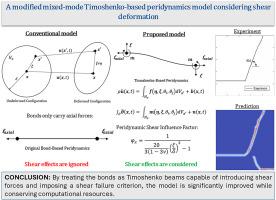A modified mixed-mode Timoshenko-based peridynamics model considering shear deformation
IF 7.1
1区 工程技术
Q1 ENGINEERING, MECHANICAL
International Journal of Mechanical Sciences
Pub Date : 2024-10-26
DOI:10.1016/j.ijmecsci.2024.109802
引用次数: 0
Abstract
The original two-dimensional bond-based peridynamic (BBPD) framework, which only considers the pairwise forces (compression and tension) between two material points, is extended by incorporating the effect of shear deformation in the calculations and its influence on the failure of the bonds. To this end, each bond is considered as a short Timoshenko beam, and by doing so, the traditional BBPD is enhanced into a more comprehensive model known as multi-polar peridynamic (MPPD). The proposed novel approach explicitly considers the shear influence factor used in Timoshenko beams and introduces a strain-based shear deformation failure criterion. The model is then validated against two benchmark experimental tests (i.e., a standard pure mode I edge crack, and a Kalthoff-Winkler configuration) reported in the literature under in-plane dynamic loading and plane stress conditions. In most cases, the developed model is shown to be more accurate in predicting the crack paths obtained from the experimental results when compared to other theoretical methods delineated in the literature. Furthermore, a noticeable change in crack branching and crack path is observed in a study on the effects of Poisson's ratio and the loading rate. This investigation also demonstrated that the proposed MPPD model can accommodate materials with Poisson's ratios up to 1/3, expanding the range beyond the traditional BBPD limitations.

考虑剪切变形的基于季莫申科混合模式的修正围流体力学模型
最初的二维键基周向力(BBPD)框架只考虑了两个材料点之间的成对力(压缩力和拉力),通过在计算中加入剪切变形效应及其对键失效的影响,该框架得到了扩展。为此,每个粘接点都被视为一个短的季莫申科梁,从而将传统的 BBPD 增强为一个更全面的模型,即多极周动力模型(MPPD)。所提出的新方法明确考虑了 Timoshenko 梁中使用的剪切影响因子,并引入了基于应变的剪切变形失效准则。然后,在面内动态加载和平面应力条件下,根据文献中报道的两个基准实验测试(即标准纯模式 I 边缘裂缝和 Kalthoff-Winkler 构型)对该模型进行了验证。在大多数情况下,与文献中描述的其他理论方法相比,所开发的模型在预测实验结果得出的裂纹路径方面更为准确。此外,在对泊松比和加载速率的影响进行研究时,观察到裂纹分支和裂纹路径发生了明显变化。这项研究还表明,所提出的 MPPD 模型可适用于泊松比高达 1/3 的材料,从而超出了传统 BBPD 的限制范围。
本文章由计算机程序翻译,如有差异,请以英文原文为准。
求助全文
约1分钟内获得全文
求助全文
来源期刊

International Journal of Mechanical Sciences
工程技术-工程:机械
CiteScore
12.80
自引率
17.80%
发文量
769
审稿时长
19 days
期刊介绍:
The International Journal of Mechanical Sciences (IJMS) serves as a global platform for the publication and dissemination of original research that contributes to a deeper scientific understanding of the fundamental disciplines within mechanical, civil, and material engineering.
The primary focus of IJMS is to showcase innovative and ground-breaking work that utilizes analytical and computational modeling techniques, such as Finite Element Method (FEM), Boundary Element Method (BEM), and mesh-free methods, among others. These modeling methods are applied to diverse fields including rigid-body mechanics (e.g., dynamics, vibration, stability), structural mechanics, metal forming, advanced materials (e.g., metals, composites, cellular, smart) behavior and applications, impact mechanics, strain localization, and other nonlinear effects (e.g., large deflections, plasticity, fracture).
Additionally, IJMS covers the realms of fluid mechanics (both external and internal flows), tribology, thermodynamics, and materials processing. These subjects collectively form the core of the journal's content.
In summary, IJMS provides a prestigious platform for researchers to present their original contributions, shedding light on analytical and computational modeling methods in various areas of mechanical engineering, as well as exploring the behavior and application of advanced materials, fluid mechanics, thermodynamics, and materials processing.
 求助内容:
求助内容: 应助结果提醒方式:
应助结果提醒方式:


